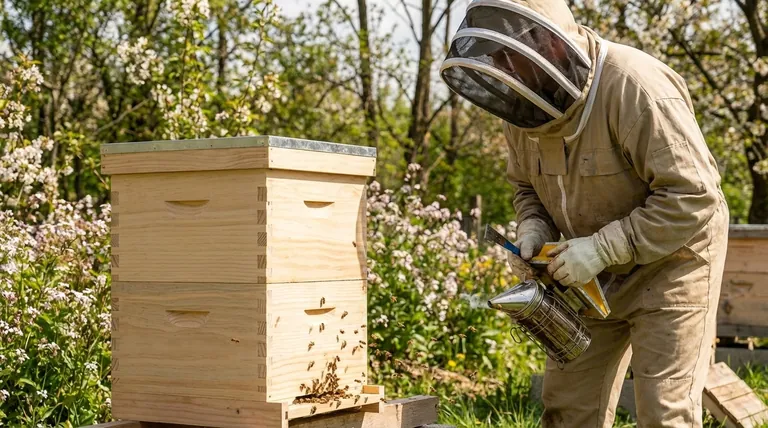To approach a beehive without alarming the colony, you must always do so from the side or the rear. Avoid the front of the hive at all costs, as this is the entrance and exit—the primary flight path for thousands of bees. Standing here is perceived as a threat by guard bees, who can trigger a defensive response across the entire hive.
The core principle is not merely about where you walk, but about respecting the hive's operational space. A calm, successful inspection depends on understanding that the area directly in front of the hive is a high-traffic zone that you must never block.

Understanding the Hive's "Airspace"
A beehive is more than just a box; it's a bustling city with its own infrastructure, including a very busy airport. Your approach must respect this established traffic flow to avoid being seen as a threat.
The Importance of the Hive Entrance
The hive entrance is the single busiest point in the entire colony. Foraging bees are constantly flying in and out, carrying pollen and nectar. Standing in front of this entrance is equivalent to standing in the middle of a busy doorway or runway.
The Bees' Flight Path
Bees establish a consistent "highway" in the air leading directly to and from the hive entrance. This path can extend several feet out. By approaching from the rear or side, you stay completely clear of this flight path, allowing the colony's work to continue uninterrupted.
The Role of Guard Bees
Guard bees are stationed at the entrance, tasked with identifying and neutralizing threats. If you block their line of sight or stand in the flight path, they will interpret you as a potential invader. This is the first step in a colony-wide alarm.
The Science of a Defensive Response
When a hive becomes defensive, it isn't random. It's a coordinated reaction triggered by specific chemical signals. Your goal is to avoid initiating this chain reaction.
The Alarm Pheromone
When a guard bee feels threatened or stings, it releases an alarm pheromone. This chemical signal instantly alerts other bees in the vicinity to the danger, essentially shouting "attack!" to its sisters.
How It Spreads Through the Colony
This pheromone spreads rapidly. One agitated guard bee can trigger others nearby, creating a cascade effect that puts thousands of bees on high alert. Once the alarm is sounded, your inspection becomes significantly more difficult and dangerous.
Preventing the Initial Trigger
By approaching from the side or rear, you avoid startling the highly sensitive guard bees at the entrance. This simple act is the most effective way to prevent that first release of alarm pheromone and keep the entire colony calm.
Understanding the Trade-offs
While the rules are simple, real-world apiary setups can present challenges. Understanding the risks helps you make the best possible decision in any scenario.
When a Rear Approach Isn't Possible
Sometimes, hives are placed against a wall, a fence, or dense foliage. If you cannot get behind the hive, a side approach is the only acceptable alternative. Move slowly and deliberately, staying as far from the front entrance corner as possible.
The Inefficiency of a Defensive Hive
Approaching from the front doesn't just risk stings; it makes your job harder. An agitated, defensive hive is nearly impossible to inspect properly. You won't be able to assess the queen, check for brood, or manage frames calmly, defeating the purpose of opening the hive in the first place.
The Role of Protective Gear
Proper protective gear, such as a full bee suit and boots, is non-negotiable. It serves as your safety net. Wearing it allows you to remain calm and move deliberately even if a few bees become agitated, preventing you from making sudden, jerky movements that would alarm the colony further.
Making the Right Choice for Your Goal
Your approach protocol should be a consistent practice tailored to ensuring a calm and productive inspection.
- If your primary focus is a routine, calm inspection: Always approach from the rear or side on a warm, sunny day when the foragers are busy.
- If your hive placement is not ideal: Your only option is a slow, deliberate side approach. Be extra cautious and watch the bees' behavior for any signs of agitation.
- If your primary focus is maximum safety: Secure your protective gear before you get near the hive. Your calm demeanor, protected by your gear, is as important as your physical path.
Ultimately, thinking like a bee is the key to becoming a better beekeeper.
Summary Table:
| Approach Method | Key Principle | Risk Level |
|---|---|---|
| Side or Rear | Avoids the hive's main flight path and guard bees. | Low |
| Front | Blocks the entrance, perceived as a major threat. | High |
Ensure your apiary operations are safe and efficient with the right equipment. HONESTBEE supplies durable beekeeping supplies and protective gear to commercial apiaries and beekeeping equipment distributors through our wholesale-focused operations. Our products are designed to help you work calmly and confidently with your colonies.
Contact HONESTBEE today to discuss your wholesale needs and enhance your beekeeping practice.
Visual Guide

Related Products
- Australian Langstroth Beehive Boxes for Beekeeping Wholesales
- Langstroth Bee Hives Bee Keeping Box for Beginners Beekeeping
- Professional Insulated Plastic Bee Hives
- HONESTBEE Professional Long Handled Hive Tool with Precision Cutting Blade
- Langstroth Honey Bee Box Hive Boxes for Different Depths
People Also Ask
- What color should beehives be painted? The Best Choice for Hive Health and Honey Production
- How many frames fit into a standard beehive box? Choose Between 8-Frame and 10-Frame Hives
- Why might a beginner be advised to start with a Langstroth hive? Unlock a Supportive Beekeeping Ecosystem
- How many deep hive bodies should I use? The Standard for a Healthy, Winter-Ready Colony
- What are the sizes of supers available in a standard hive? A Guide to Deep, Medium, and Shallow Boxes



















